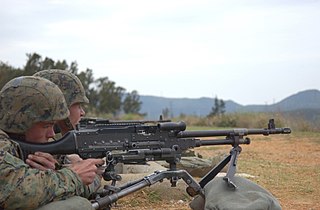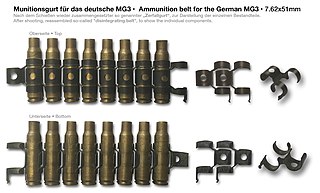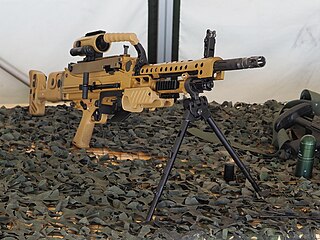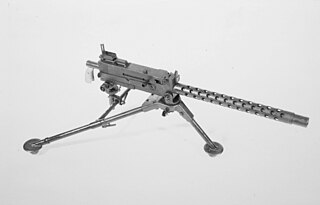The MG 34 is a German recoil-operated air-cooled general-purpose machine gun, first tested in 1929, introduced in 1934, and issued to units in 1936. It introduced an entirely new concept in automatic firepower – the Einheitsmaschinengewehr – and is generally considered the world's first general-purpose machine gun (GPMG). Both the MG 34 and MG 42 were erroneously nicknamed "Spandau" by Allied troops, a carryover from the World War I nickname for the MG 08, which was produced at the Spandau Arsenal.
The MG 42 is a German recoil-operated air-cooled general-purpose machine gun used extensively by the Wehrmacht and the Waffen-SS during the second half of World War II. Entering production in 1942, it was intended to supplement and replace the earlier MG 34, which was more expensive and took much longer to produce, but both weapons were produced until the end of World War II.

A light machine gun (LMG) is a light-weight machine gun designed to be operated by a single infantryman, with or without an assistant, as an infantry support weapon. LMGs firing cartridges of the same caliber as the other riflemen of the same combat unit are often referred to as squad automatic weapons.
The M60, officially the Machine Gun, Caliber 7.62 mm, M60, is a family of American general-purpose machine guns firing 7.62×51mm NATO cartridges from a disintegrating belt of M13 links. There are several types of ammunition approved for use in the M60, including ball, tracer, and armor-piercing rounds.

A magazine, often simply called a mag, is an ammunition storage and feeding device for a repeating firearm, either integral within the gun or externally attached. The magazine functions by holding several cartridges within itself and sequentially pushing each one into a position where it may be readily loaded into the barrel chamber by the firearm's moving action. The detachable magazine is sometimes colloquially referred to as a "clip", although this is technically inaccurate since a clip is actually an accessory device used to help load ammunition into a magazine or cylinder.

The PK is a belt-fed general-purpose machine gun, chambered for the 7.62×54mmR rimmed cartridge.

The Stoner 63 is a 5.56×45mm NATO modular weapon system. Using a variety of modular components, it can be configured as an assault rifle, carbine, top-fed light machine gun, belt-fed squad automatic weapon, or as a vehicle mounted weapon. Also known as the M63, XM22, XM23, XM207 or the Mk 23 Mod 0 machine gun, it was designed by Eugene Stoner in the early 1960s. Cadillac Gage was the primary manufacturer of the Stoner 63 during its history. The Stoner 63 saw very limited combat use by United States forces during the Vietnam War. A few were also sold to law enforcement agencies.

The MG 3 is a German general-purpose machine gun chambered for the 7.62×51mm NATO cartridge. The weapon's design is derived from the World War II era MG 42 that fired the 7.92×57mm Mauser round.

A heavy machine gun (HMG) is significantly larger than light, medium or general-purpose machine guns. HMGs are typically too heavy to be man-portable and require mounting onto a weapons platform to be operably stable or tactically mobile, have more formidable firepower, and generally require a team of personnel for operation and maintenance.

A medium machine gun (MMG), in modern terms, usually refers to a belt-fed machine gun firing a full-powered rifle cartridge, and is considered "medium" in weight. Medium machine guns are light enough to be infantry-portable, but still cumbersome enough to require a crew for optimal operational efficiency.
The ShKAS is a 7.62 mm calibre machine gun widely used by Soviet aircraft in the 1930s and during World War II. The ShKAS had the highest rate of fire of any aircraft machine gun in general service during WWII. It was designed by Boris Shpitalniy and Irinarkh Komaritsky and entered production in 1934. ShKAS was used in the majority of Soviet fighters and bombers and served as the basis for the ShVAK cannon.

The HK21 is a German 7.62 mm general-purpose machine gun, developed in 1961 by small arms manufacturer Heckler & Koch and based on the G3 battle rifle. The weapon is in use with the armed forces of several Asian, African and Latin American countries. It was also license-manufactured by Fábrica de Braço de Prata in Portugal as the m/968 and in Mexico by SEDENA as the MG21. In the German military (Bundeswehr) and the federal police (Bundespolizei) it is designated "G8".

The SIG MG 710-3 is a Swiss 7.62 mm general-purpose machine gun (GPMG) designed and manufactured by SIG - Schweizerische Industrie Gesellschaft. The weapon was developed as a commercial venture primarily for export, since the Swiss Army had already adopted the 7.5 mm MG 51 GPMG, produced by the federal arms factory W+F.
The Ameli is a 5.56mm light machine gun designed for the Spanish Army by the nationally owned and operated Centro de Estudios Técnicos de Materiales Especiales (CETME) small arms research institute.

The M13 link, formally Link, Cartridge, Metallic Belt, 7.62mm, M13, is the U.S. military designation for a metallic disintegrating link specifically designed for ammunition belt-fed firearms and 7.62×51mm NATO rounds. It was introduced in the mid-20th century. It is the primary link type for the United States and among NATO for the 7.62×51mm NATO cartridge. As of 2017, it has been in use for over 60 years and is used on the Dillon M134D Minigun, M60 Machine Gun, FN MAG/M240, Mk 48, MG3, HK21, MG5, UKM-2000, K12, SS-77 and Negev NG-7, among others. Some countries redesignated the M13 link when it was adopted.
The M1 link, was the U.S. military designation for a steel disintegrating link designed for the M1917 Browning machine gun and M1919 Browning machine gun, and the .30-06 Springfield cartridge that they fired. A single round would hold two links together, and more could be added to make up a belt of any quantity of rounds, though for the mounted machine guns of the time, a belt of 250 rounds was most commonly used. As was the trend with American belt-fed firearms, as opposed to Soviet designs, belts of ammunition feed into the gun from the left side to the right.

The M27 link, formally Link, Cartridge, Metallic Belt, 5.56mm, M27 is a metallic disintegrating link issued by the United States armed forces and among NATO and designed for use in belt-fed firearms. It holds 5.56×45mm NATO ammunition.
The Rikhter R-23 is an aircraft autocannon developed for the Soviet Air Force starting in the late 1950s. It was designed to be as short as possible to avoid problems found on high-speed aircraft when the guns were pointed into the airstream. The R-23 was a gas operated revolver cannon that used gas bled from holes in the barrel to provide the motive force. Firing up to 2,600 rpm, the R-23 was the fastest firing single-barrel cannon ever introduced into service.

The Heckler & Koch MG5 is a belt-fed 7.62×51mm NATO general-purpose machine gun manufactured by German firearm manufacturer Heckler & Koch. The MG5 resembles the 5.56×45mm NATO Heckler & Koch MG4 light machine gun, which was adopted into German military service in 2015.

The M1919 Browning is a .30 caliber medium machine gun that was widely used during the 20th century, especially during World War II, the Korean War, and the Vietnam War. The M1919 saw service as a light infantry, coaxial, mounted, aircraft, and anti-aircraft machine gun by the U.S. and many other countries.


















